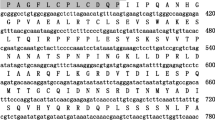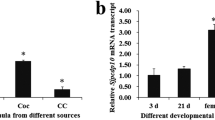Abstract
Nanos is a necessary factor in the differentiation and migration of primordial germ cells. It is closely associated with the development of genitalia in a wide range of species. We questioned whether Nanos was involved in the reproductive organ development of Schistosoma japonicum. Firstly, by in situ hybridization, S. japonicum Nanos1 (SjNanos1) gene was expressed mainly in reproductive organs of S. japonicum. Then, the paired schistosome of 28 days post-infection (dpi) was transfected with SjNanos1 small interfering RNA three times and cultured in vitro for 10 days. SjNanos1 expression suppression in the mRNA and protein levels were confirmed compared to that of the controls. The morphological changes in reproductive organs and egg production were observed after SjNanos1 gene knockdown. The results observed by confocal laser scanning microscopy showed significant changes in the morphology of reproductive organs of parasites, especially the female ovaries, vitellarium, and the male testes, after RNAi. In addition, SjNanos1 silencing also induced the reduction of eggs, and affected the changes of reproduction-related genes, like Pumilio, CNOT6L, and Fs800. Therefore, our findings demonstrate that the SjNanos1 gene is essential in the development of reproductive organs and the egg production of S. japonicum.







Similar content being viewed by others
References
Andrade ZA (2009) Schistosomiasis and liver fibrosis. Parasite Immunol 31(11):656–663
Bartlam M, Yamamoto T (2010) The structural basis for deadenylation by the CCR4-NOT complex. Protein Cell 1(5):443–452
Basch PF (1981) Cultivation of Schistosoma mansoni in vitro. I. Establishment of cultures from cercariae and development until pairing. J Parasitol 67(2):179–185
Beckmann S, Grevelding CG (2010) Imatinib has a fatal impact on morphology, pairing stability and survival of adult Schistosoma mansoni in vitro. Int J Parasitol 40(5):521–526
Beckmann S, Quack T, Burmeister C, Buro C, Long T, Dissous C, Grevelding CG (2010) Schistosoma mansoni: signal transduction processes during the development of the reproductive organs. Parasitology 137(3):497–520
Berthet C, Morera AM, Asensio MJ, Chauvin MA, Morel AP, Dijoud F, Magaud JP, Durand P, Rouault JP (2004) CCR4-associated factor CAF1 is an essential factor for spermatogenesis. Mol Cell Biol 24(13):5808–5820
Cheng GF, Lin JJ, Feng XG, Fu ZQ, Jin YM, Yuan CX, Zhou YC, Cai YM (2005) Proteomic analysis of differentially expressed proteins between the male and female worm of Schistosoma japonicum after pairing. Proteomics 5(2):511–521
Chuah C, Jones MK, Burke ML, McManus DP, Gobert GN (2014) Cellular and chemokine-mediated regulation in schistosome-induced hepatic pathology. Trends Parasitol 30(3):141–150
Cogswell AA, Collins JJ 3rd, Newmark PA, Williams DL (2011) Whole mount in situ hybridization methodology for Schistosoma mansoni. Mol Biochem Parasitol 178(1–2):46–50
Collins JJ 3rd, Wang B, Lambrus BG, Tharp ME, Iyer H, Newmark PA (2013) Adult somatic stem cells in the human parasite Schistosoma mansoni. Nature 494(7438):476–479
Dahanukar A, Wharton RP (1996) The Nanos gradient in Drosophila embryos is generated by translational regulation. Genes Dev 10(20):2610–2620
deWalick S, Tielens AG, van Hellemond JJ (2012) Schistosoma mansoni: the egg, biosynthesis of the shell and interaction with the host. Exp Parasitol 132(1):7–13
Diao YJ, Hua MQ, Shao YJ, Huang W, Liu M, Ren CP, Ji YS, Chen JM, Shen JJ (2015) Preliminary characterization and expression of vasa-like gene in Schistosoma japonicum. Parasitol Res 114(7):2679–2687
Draper BW, McCallum CM, Moens CB (2007) Nanos1 is required to maintain oocyte production in adult zebrafish. Dev Biol 305(2):589–598
Fenwick A (2015) Praziquantel: do we need another antischistosoma treatment? Future Med Chem 7(6):677–680
Fitzpatrick JM, Hoffmann KF (2006) Dioecious Schistosoma mansoni express divergent gene repertoires regulated by pairing. Int J Parasitol 36(10–11):1081–1089
Hams E, Aviello G, Fallon PG (2013) The schistosoma granuloma: friend or foe? Front Immunol 4:89
Hotez PJ, Alvarado M, Basáñez MG et al (2014) The global burden of disease study 2010: interpretation and implications for the neglected tropical diseases. PLoS Negl Trop Dis 8(7):e2865
Hulstijn M, Barros LA, Neves RH, Moura EG, Machado-Silva JR (2003) Morphological changes in the reproductive organs of male and female Schistosoma mansoni worms caused by streptozotocin, a drug used to induce diabetes mellitus. Parasitology 126(Pt 1):53–61
Hülskamp M, Schröder C, Pfeifle C, Jäckle H, Tautz D (1989) Posterior segmentation of the Drosophila embryo in the absence of a maternal posterior organizer gene. Nature 338(6217):629–632
Kunz W (2001) Schistosome male-female interaction: induction of germ-cell differentiation. Trends Parasitol 17(5):227–231
Lai F, Singh A, King ML (2012) Xenopus Nanos1 is required to prevent endoderm gene expression and apoptosis in primordial germ cells. Development 139(8):1476–1486
Liu S, Cai P, Hou N, Piao X, Wang H, Hung T, Chen Q (2012) Genome-wide identification and characterization of a panel of house-keeping genes in Schistosoma japonicum. Mol Biochem Parasitol 182(1–2):75–82
Livak KJ, Schmittgen TD (2001) Analysis of relative gene expression data using real-time quantitative PCR and the 2(−delta delta C(T)) method. Methods 25(4):402–408
Lu Z, Quack T, Hahnel S et al (2015) Isolation, enrichment and primary characterisation of vitelline cells from Schistosoma mansoni obtained by the organ isolation method. Int J Parasitol 45(9–10):663–672
McManus DP, Loukas A (2008) Current status of vaccines for schistosomiasis. Clin Microbiol Rev 21(1):225–242
Milligan JN, Jolly ER (2012) Identification and characterization of a Mef2 transcriptional activator in schistosome parasites. PLoS Negl Trop Dis 6(1):e1443
Murray CJ, Barber RM, Foreman KJ et al (2015) Global, regional, and national disability-adjusted life years (DALYs) for 306 diseases and injuries and healthy life expectancy (HALE) for 188 countries, 1990–2013: quantifying the epidemiological transition. Lancet 386(10009):2145–2191
Oulhen N, Wessel GM (2016) Differential Nanos 2 protein stability results in selective germ cell accumulation in the sea urchin. Dev Biol 418(1):146–156
Oulhen N, Wessel GM (2014) Every which way—nanos gene regulation in echinoderms. Genesis 52(3):279–286
Popiel I, Basch PF (1984) Reproductive development of female Schistosoma mansoni (Digenea: Schistosomatidae) following bisexual pairing of worms and worm segments. J Exp Zool 232(1):141–150
Reis MG, Kuhns J, Blanton R, Davis AH (1989) Localization and pattern of expression of a female specific mRNA in Schistosoma mansoni. Mol Biochem Parasitol 32(2–3):113–119
Schmitt-Engel C, Cerny AC, Schoppmeier M (2012) A dual role for nanos and pumilio in anterior and posterior blastodermal patterning of the short-germ beetle Tribolium castaneum. Dev Biol 364(2):224–235
Subramaniam K, Seydoux G (1999) Nos-1 and Nos-2, two genes related to Drosophila nanos, regulate primordial germ cell development and survival in Caenorhabditis elegans. Development 126(21):4861–4871
Vanderstraete M, Gouignard N, Cailliau K, Morel M, Lancelot J, Bodart JF, Dissous C (2013) Dual targeting of insulin and venus kinase receptors of Schistosoma mansoni for novel anti-schistosome therapy. PLoS Negl Trop Dis 7(5):e2226
Wang B, Collins JJ 3rd, Newmark PA (2013) Functional genomic characterization of neoblast-like stem cells in larval Schistosoma mansoni. elife 2:e00768
Wang C, Dickinson LK, Lehmann R (1994) Genetics of nanos localization in Drosophila. Dev Dyn 199(2):103–115
Yang Y, Jin Y, Liu P, Shi Y, Cao Y, Liu J, Shi Y, Li H, Lin J (2012) RNAi silencing of type V collagen in Schistosoma japonicum affects parasite morphology, spawning, and hatching. Parasitol Res 111(3):1251–1257
Ye B, Petritsch C, Clark IE, Gavis ER, Jan LY, Jan YN (2004) Nanos and Pumilio are essential for dendrite morphogenesis in Drosophila peripheral neurons. Curr Biol 14(4):314–321
Zhao G, Chen K, Yao Q, Wang W, Wang Y, Mu R, Chen H, Yang H, Zhou H (2008) The nanos gene of Bombyx mori and its expression patterns in developmental embryos and larvae tissues. Gene Expr Patterns 8(4):254–260
Ziros PG, Chartoumpekis DV, Sykiotis GP (2016) A simple protocol for high efficiency protein isolation after RNA isolation from mouse thyroid and other very small tissue Samples. Methods Mol Biol 1449:383–393
Acknowledgements
This work was supported by the Natural Science Foundation of China (81271865), Key University Science Research Project of Anhui Province of China (KJ2016A333) and Scientific Research of BSKY from Anhui Medical University (XJ201321). We thank Dr. Adams Latif (a native English speaker, Anhui Medical University Laboratory of Microbiology) for modifying the manuscript.
Author information
Authors and Affiliations
Corresponding authors
Ethics declarations
Conflict of interest
The authors declare that they have no conflict of interest.
Electronic supplementary material
Rights and permissions
About this article
Cite this article
Liu, Q., Zhu, L., Liu, F. et al. Function of Nanos1 gene in the development of reproductive organs of Schistosoma japonicum . Parasitol Res 116, 1505–1513 (2017). https://doi.org/10.1007/s00436-017-5427-9
Received:
Accepted:
Published:
Issue Date:
DOI: https://doi.org/10.1007/s00436-017-5427-9




